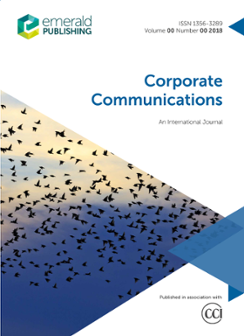Table of contents
It’s about how employees feel! examining the impact of emotional culture on employee–organization relationships
Linjuan Rita Men, Katy L. RobinsonThe purpose of this paper is to examine the impact of emotional culture on the quality of employee–organization relationships (EORs). To understand the nuances of the influence of…
Reviewing corporate social responsibility communication: a legitimacy perspective
Anne Ellerup Nielsen, Christa ThomsenThe purpose of this paper is to answer the call for CSR communication research to develop and substantiate outcomes that may better explain CSR communication strategies and…
Internal, external, and media stakeholders’ evaluations during transgressions
Isabelle Koehler, Sascha RaithelAs crises are largely perceptual, the deeper the understanding is of how stakeholders perceive crisis situations, the more effectively corporations can target their crisis…
“Walking the environmental responsibility talk” in the automobile industry: An ethics case study of the Volkswagen environmental scandal
Chiara Valentini, Dean KruckebergThe purpose of this paper is to discuss the corporate behavior of Volkswagen in its emissions scandal. It describes and analyzes a complex ethics dilemma within the purview of…
“English is an unwritten rule here”: Non-formalised language policies in multinational corporations
Guro R. Sanden, Anne KankaanrantaThe purpose of this paper is to examine the implications of corporate language policies that are implemented without formal decision-making processes.
Theoretical insights on integrated reporting: The inclusion of non-financial capitals in corporate disclosures
Mark Anthony CamilleriCorporations and large entities are increasingly disclosing material information on their financial and non-financial capitals in integrated reports (IR). The rationale behind…
Relative leader-member relationships within group context: Linking group cooperation to perceived group performance
Hassan Abu Bakar, Leah M. Omilion-HodgesAlthough the importance of group leader and group member dyadic relationships has been increasingly emphasized, only few studies have focused on the dyadic level analysis of…
When hierarchy becomes collaborative: Collaboration as sensemaking frame in high reliability organizing
Rebecca M. RiceThe purpose of this paper is to expand understandings of interorganizational collaboration among high reliability organizations (HROs). It proposes that HROs face unique needs for…
Participatory communication on internal social media – a dream or reality?: Findings from two exploratory studies of coworkers as communicators
Vibeke Thøis MadsenThe purpose of this paper is to explore whether internal social media (ISM) introduces a new kind of participatory communication within organizations that is capable of…
Examining public perceptions of CSR in sport
Joon Kyoung Kim, Holly Overton, Kevin Hull, Minhee ChoiThe purpose of this paper is to investigate how the public views two corporate social responsibility (CSR) initiatives practiced by a Major League Baseball (MLB) team. This study…
Are emojis fascinating brand value more than textual language? Mediating role of brand communication to SNS and brand attachment: An insight from India
Vikas Arya, Deepa Sethi, Hemraj VermaThe purpose of this paper is to understand the relationship of consumers’ engagement on social networking sites (SNSs) and their brand attachment behavior in the presence of a…

ISSN:
1356-3289Online date, start – end:
1996Copyright Holder:
Emerald Publishing LimitedOpen Access:
hybridEditor:
- Martina Topic